Selecting high-linearity mixers for wireless base stations
Abstract: Today's communication systems, such as wireless base stations, make strong demands on receiver sensitivity and large-signal performance. This article focuses on mixers, and describes key mixer performance issues and the basic parameters specified in data sheets. The article explains how to select the best mixer to optimize the receive channel.
A similar article appeared in German in Elektronik Informationen in July 2008, and in English in High Frequency Electronics magazine in October 2009.
Introduction
The communication standards for wireless base stations—e.g., GSM, UMTS, and (now) LTE—define minimum specifications for various parameters including receiver sensitivity and performance in the presence of large signals. These key requirements make heavy demands on every functional block of the radio in a wireless base station. In the receive signal path, mixer performance has a major impact on the receiver's sensitivity and large-signal performance. This article describes key mixer performance issues and parameters to help you select the best mixer for your receive channel.
A wireless base-station receiver
To start, we first analyze the block diagram of a typical receiver used in wireless base stations (Figure 1). These receivers are called superheterodyne receivers because the received signal undergoes two consecutive downconversions to lower frequencies. As shown, the signal is received by the antenna and then filtered by RF filter 1, which is normally used to filter out trash signals. This filter output is then amplified by an LNA (low-noise amplifier), which normally has a very low noise figure.
Figure 1. Block diagram of a typical wireless base-station receiver.
The amplified signal is again filtered, this time by RF filter 2, which limits the frequency range while filtering out unwanted signals that can limit the mixer's performance. The filtered and band-limited signal is then fed to the first mixer, where it is downconverted to an IF frequency by mixing with an LO's (local oscillator's) signal. Depending on the receiver's architecture, this IF signal can be further downconverted to a second, lower-IF frequency, and then demodulated for processing in the baseband.
We now examine the mixers in this receiver chain. The mixers' parameters should be investigated because they have a major effect on the receiver's sensitivity and large-signal performance.
Mixer parameters
The noise figure of a mixer describes the degradation in SNR (signal-to-noise ratio) from input to output. That ratio is normally expressed in the logarithmic measure of decibels (dB), as shown in Equation 1:
(Eq. 1)
A second important parameter is the conversion gain (or alternatively, conversion loss). Conversion gain gives an important indication whether the mixer configuration is active or passive. Passive mixers have insertion loss (called conversion loss) because they include no components for amplifying the signal. Active mixers, however, have active components and provide conversion gain.
An active mixer can be realized in either of two configurations: as an integrated mixer based on a balanced (Gilbert cell) design; or as a passive mixer that is combined with an IF amplifier stage to provide gain instead of loss. Because the integrated mixer has gain, it requires no external IF amplifier stage to make up for insertion loss.
(Eq. 2)
Conversion gain (or loss) is a logarithmic measure expressed in dB, as seen in Equation 2. It is frequency dependent, and should be specified over the mixer's entire operating frequency range. To ensure optimal receiver performance, the variation of conversion gain/loss over the specified frequency range should be as small as possible.
Because wireless base stations usually operate in a fluctuating temperature environment, the conversion gain/loss should also be specified over the operating temperature range, again with as small a variation as possible. This temperature range is important because under normal conditions a small variation with temperature allows a smaller headroom, which is useful in system planning.
The large-signal behavior of a mixer is described by a mixer parameter called the "1dB compression point," also called compression point (IP1dB), and the second- and third-order intercept points (IP2 and IP3). The IP1dB compression point predicts the level of input power at which the mixer gain is reduced by 1dB, with respect to the linear expression in Equation 3:
POUT = G × PIN (Eq. 3)
A mixer should also be able to convert a weak signal when two large signals of nearly the same frequency are applied to the mixer's input. This behavior is normally described by the third-order intercept point (IP3), which together with the noise figure describes the dynamic range of the mixer. A large IP3 indicates a high-linearity mixer. The mixer's data sheet should also specify intercept points for the mixer's input and output. Using Equation 4, you can calculate the OIP3 (output intercept point) from the IIP3 (input intercept point), and vice versa:
OIP3 = IIP3 + G (Eq. 4)
Where OIP3 is the intercept point at the mixer's output, IIP3 at the input, and G is the conversion loss or gain. The OIP3 for a passive mixer is, therefore, reduced by the mixer's conversion loss. This insertion loss requires compensation in either the RF or IF gain stages in order to establish the receiver's desired overall noise figure. (The noise figure is an additional parameter that must be accounted for in the receiver design.)
Passive vs. active mixers
A major advantage of passive mixers is that they can also be used as frequency upconverters. In other words, their input signals can be converted to a higher frequency. An upconverter is normally employed in a transmitter chain, where it converts an IF signal to the final transmit frequency. Because a passive mixer can be used in the transmit chain as well as the receiver chain, you need to order and stock only one component.
A "direct downconversion receiver" directly downconverts input signals to the baseband without requiring an IF signal. For these receivers, the mixer's data sheet should specify another important parameter called port-to-port isolation. This parameter measures the amount of isolation between the LO's signal and the mixer's input signal. If port-to-port isolation is not large enough, the LO can mix with itself, producing a DC offset at the mixer output that degrades the receiver's performance.
Because a mixer converts frequencies, it generates new frequencies called mixer spurs. Spurs should be investigated thoroughly, especially those at (2RF - 2LO), (3RF - 3LO), and higher orders that affect the receiver by coinciding with its IF frequencies. This behavior is usually described in a mixer's data sheet by the 2x2 and 3x3 parameters.
Besides these various parameters, you must also consider the level of integration. Some applications can benefit by integrating the mixer core with an LO amplifier, baluns, and LO switch.
A common PCB receiver layout yields design flexibility
Today the development effort can be reduced by using one layout for different frequency ranges. A receiver designed for a 900MHz GSM system can then be used for an 1800MHz GSM system, just by changing a few key components.
A family of pin-compatible mixers is ideally suited for applications in which a common PCB layout accommodates multiple frequency bands for the wireless infrastructure. The ultimate goal is to develop a single layout for a multistandard wireless base station that handles GSM, UMTS, WiMAX™, and LTE.
A passive mixer like the MAX2029 in the receiver chain, for example, can downconvert the receiver signal, while another identical mixer in the transmitter can upconvert the IF signal to the final transmit frequency. The circuit in Figure 2 integrates all the external components: LO buffer amplifier, baluns, and LO switch.
Figure 2. Block diagram of a passive mixer.
Used as a downconverter, the MAX2029 delivers 36.5dBm of IIP3, 27dBm of IP1dB, 6.5dB of conversion loss, and a 6.7dB noise figure. Because the MAX2029's SiGe process technology enables impressive performance, it is well suited for base-station applications in which high linearity and a low noise figure are critical.
The 2RF - 2LO rejection (72dBc with a -10dBm RF input signal) enables simpler and more cost-effective filters by easing the requirements for filtering the close-in harmonics. The MAX2029 expands the frequency range at the lower end from 815MHz to 1000MHz. As one member of a pin-compatible mixer family, which includes the MAX2039 and MAX2041, the MAX2029 allows the creation of a single PCB layout for receivers that handles different frequency ranges and different communication standards.
Active mixers can take the form of either a balanced (Gilbert Cell) design, or a passive mixer combined with an IF amplifier stage. The MAX9986, for example, represents the second configuration. Its high noise figure allows less RF gain ahead of the mixer stage, which in turn enables better overall linearity for the receiver. Again, as more gain is added in front of the mixer to minimize the cascaded noise figure, the mixer's linearity must be higher to maintain overall receiver linearity.
Choose the right mixer
When searching the Internet for a mixer, the challenge is to sift through all the specifications listed for the various mixers. Then you must make an optimum choice. Fortunately, a web-based parametric search tool will help you do just that. The parametric search enables design engineers to quickly find the right IC for an application. A single page shows all the search criteria for filtering information and all the corresponding parts. Changing any of these criteria updates the parts list immediately. Search features include single-click filtering, sliding filter controls, multilevel sorting, and abundant tool tips. There is no easier way to find the right part for an application.
Figure 3 shows the search results for an active mixer with 10dB gain, designed especially for base stations. The part proposed is a MAX9986. An additional click on that component leads the user directly to the component's QuickView homepage, where the associated data sheet, application notes, and other information can be found.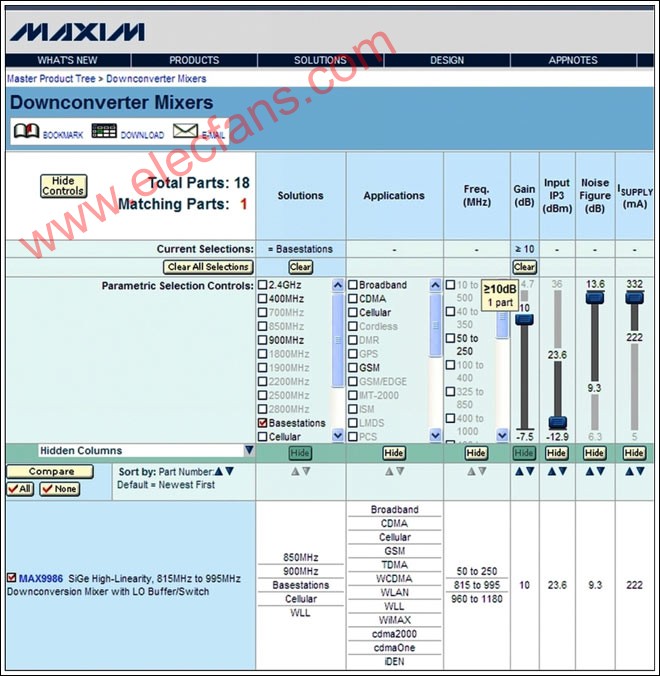
More detailed image (PDF, 2.2MB)
Figure 3. This web tool reveals the number of products matching the filter settings—before a user clicks!
A parametric search with this web tool from Maxim reveals the number of products that match a specific combination of filter settings—before the user makes the first click! The "smart" search algorithm shows only valid criteria. The user cannot make selections that eliminate all parts. Built using the latest Web 2.0 technologies, this parametric search requires no plug-ins on the user's system.
 电子发烧友App
电子发烧友App











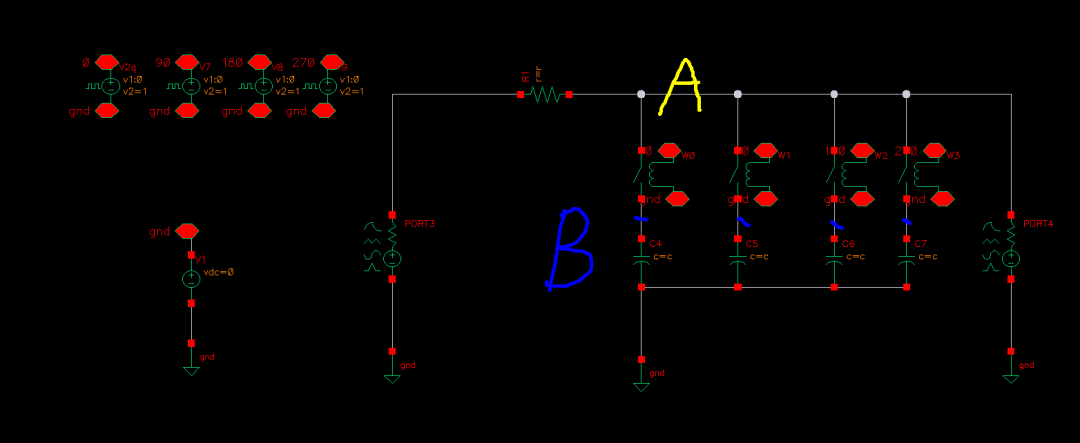

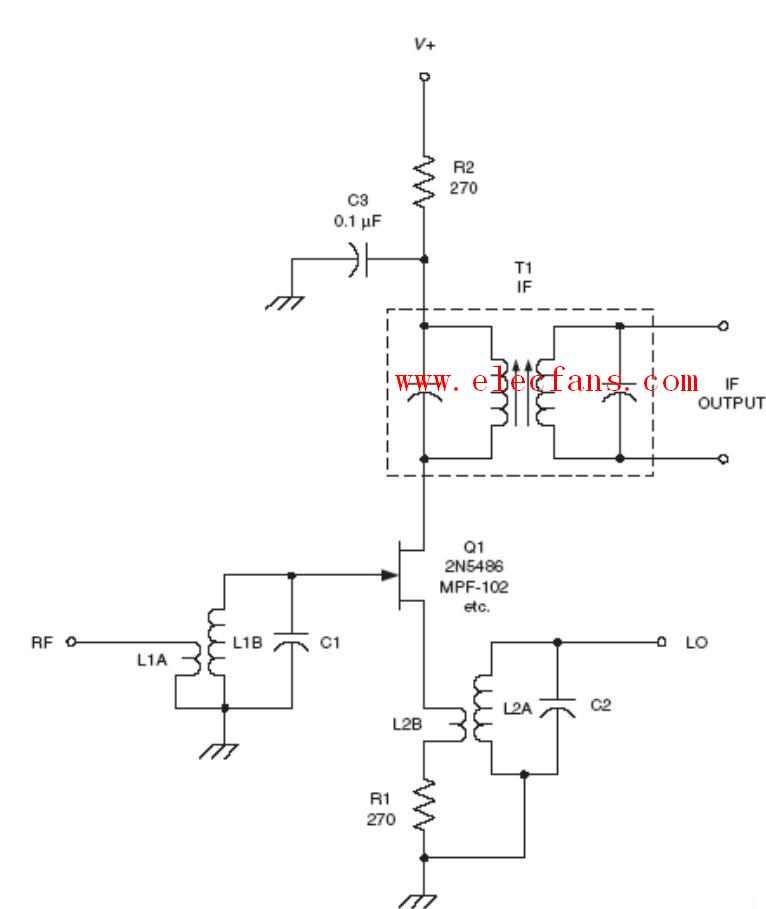
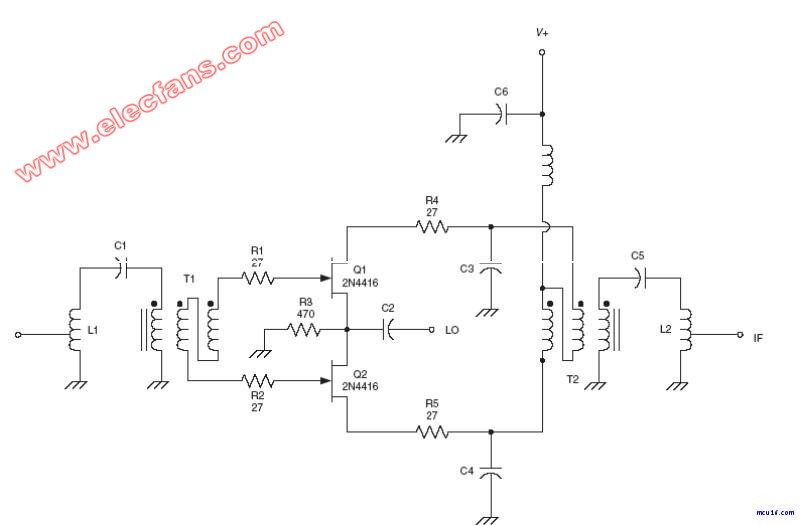
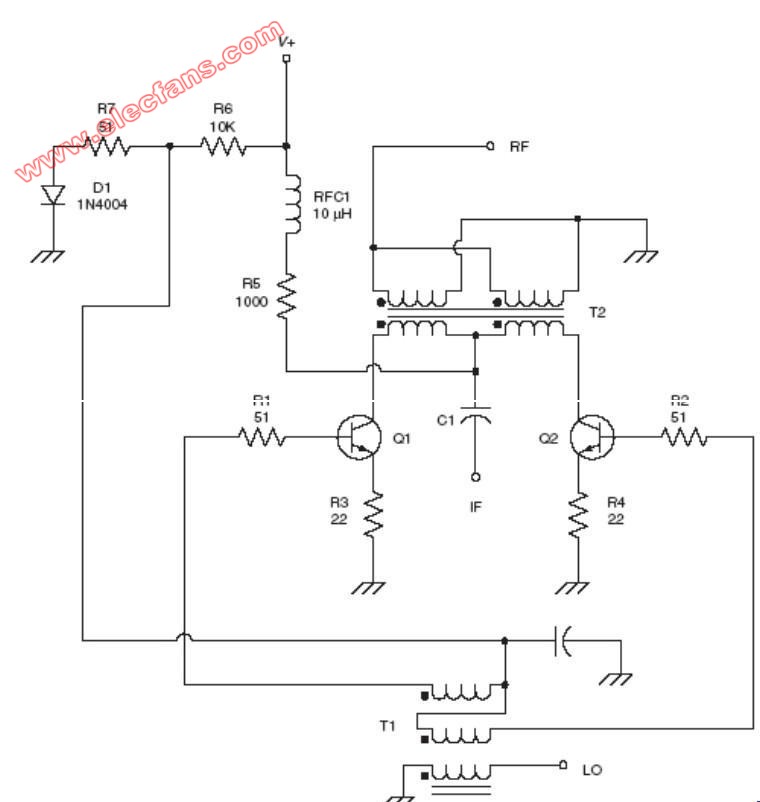
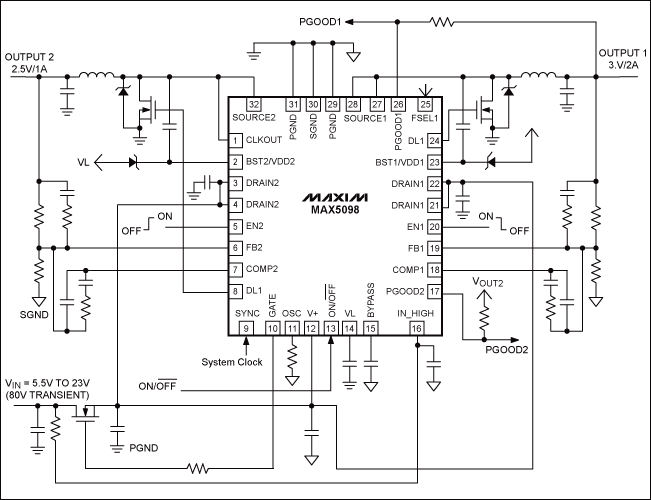
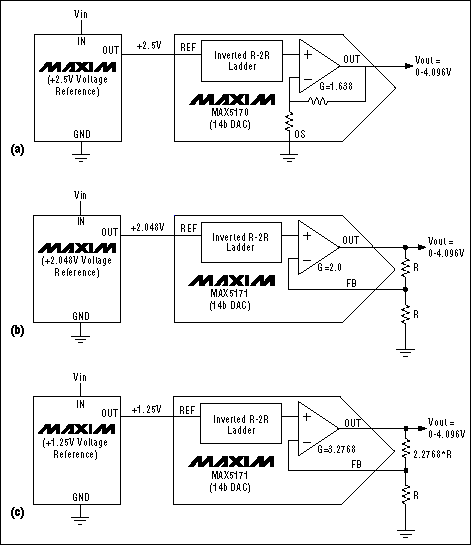
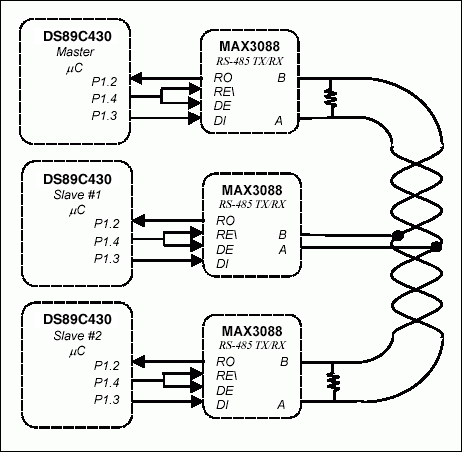

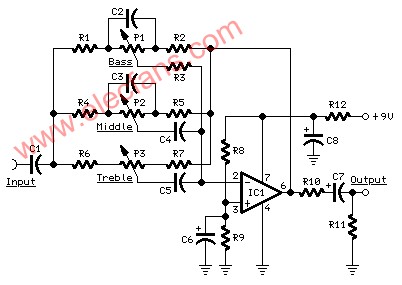
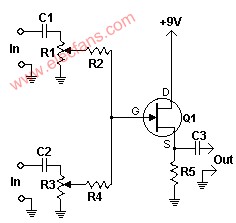












评论